
Kazi Wahaj Athar's Project

Completed the UI Design Program in September 2019, currently is studying the UX Design with us.
“Ever since I was a teenager, I wanted to do something with design. I used to draw on my notebook, patterns and such. I didn’t really know what it was back then. But I knew that it was something I liked doing. I also did calligraphy as a hobby. When I got my first phone I used to change the theme of the phone from time to time to see how different colors and patterns would look like. Long story short, a few years down the line. A friend of mine introduced me to the concept of UX design and I immediately latched onto it. I always wanted to learn something related to design. So this seemed just right. I did some research and CareerFoundry came up as one of the best online platforms out there. It was definitely worth it at the end”.
Check out his project Pace – a commuting app
What is Pace?
Pace is a commuting app that allows users to book rides and go where they want to go. The idea is to have the option of a monthly pass so that users can have a subscription to the app, which may allow them to book unlimited rides for a whole month.
The reason being that public transport can be slow and unreliable, whilst using Pace can allow people to have a more relaxed schedule. Moreover, it’s way faster than public transport and saves time.
Design guidelines
The following discourse was due to a student project. The purpose was to exercise and gain an understanding of iOS and Android guidelines. Both platforms have their respective trademarks and there was a lot to consider and comprehend. From the finer details to the overall layout. There were both major and minor differences.
Design Process
Design is a step by step process and especially when it comes to strategic planning, all aspects have to be taken into account.

Competitive Research
There are already a few competitors out there with regards to this particular project. A total of 4 apps were considered as the target competition. The companies are as follows

Research Goals
The goal is to ultimately;
- Build a user friendly app that takes into account all kinds of users, such as the elderly
- Something that the users can rely on and not just use as a last resort, late night taxi app
- Having a subscription plan for the app
Problems and Solutions
After carefully examining the competitors, a common theme emerged.
- None of the apps under focus offers a monthly subscription plan that involves unlimited rides within a particular zone.
- Because there aren’t any zones; the app just bases the fare based on the distance covered by the driver
Solution
- Engage users with the chance of having a monthly subscription plan
- Give users an incentive to come back to the app as their go-to mode of transportation
- Make it competitive with the local transportation by making the subscription affordable (Case: Helsinki, Finland)
Case Studies
To further extend the extensiveness of the study, two apps were chosen for a comprehensive analysis study. The two apps chosen were namely; Uber and Lyft. Let’s take a more detailed look at the aforementioned platforms.

1. Competitor Overview
A analysis was carried out based on a series of assessment indicators
Key Objective
The over-aching goal of the platform is to provide the users a mode of transportation that is reliable, fast and convenient. Also to give users a different option to their regular mode of transportation as traditional means of transportation could prove to be cumbersome.
Overall Strategy
The message is clear and is to get people to use the platform as an alternative to using their own car or getting a cab. However, the company has ventured into numerous transport related business such as shipments, delivering food products, and even steam rolling into the world of aviation with their ambitious aerial transportation plans.
Market Advantage
Uber pioneered this type of mood of transportation and therefore is the most widely spread and popular commuting app. Currently no other platforms provides such a versatile plan for the future as Uber.
Ratings
App Store: 4.7 based on 1 million users
Google Play Store: 4.2 based on 6 million users
Bottom Line
The platform doesn’t incorporate a monthly pass that users can use to have a go-to place for commuting every month.
2. Marketing Profile
According to Uber, they have 15 million+ rides a day and this still accounts for less than 1% of the global transportation share. Obviously it’s a huge network operating over 630 + cities worldwide. The company has recently ventured into the food delivery business as well as ‘Uber Eats’ and also moving into the aviation business.
3. SWOT Analysis
Strengths
Uber has a huge online presence and therefore enjoys the benefit of expanding beyond disciplines i.e. into the food business, aviation and others.
Weaknesses
For some reason, the company doesn’t want to have a subscription plan for their uses. Moreover, they seem to have no plans of doing that.
Opportunities
With the recent advancements in their sector of expertise, Uber has pretty much availed all they can at the moment. However, depending on the region that they are operating in, they could implement specialised plans.
Threats
Other companies such as Yango, here in Finland, are offering cheaper fares and could capture the market share.
4. UX Analysis
Usability, Layout and Navigation
The overall usability of the app is very good. The flow is smooth and easy. The hamburger menu tucks away all the information nicely to the side. The ‘pickup point’ bar is location nicely at the bottom and allows for easy reachability. The UI is very minimalistic. It has the bare minimum to get the job done.
Compatibility
The app mostly just works on mobile devices and is not very compatible once you switch your phone. For the longest time, It was hard for me log into my account. But the issue seems to be have been fixed.
Differentiation
The lead that Uber has over the market is significant and therefore no other platform right now could compete with Uber. However. depending on the region there are market shares to be captured.
Calls to Action
The users have to register to the app through their phone number initially but there aren’t any annoying platforms that one might to deal with once the initial registration is complete.

1. Competitor Overview
Key Objective
Allow people to book and share rides at a competitive price point. Follows roughly the same model as Uber.
Overall Strategy
The strategy involves engaging users and communities through creating jobs for people who would like to earn money with their own personalised time table. The driver’s are chosen through rigorous background checks. The passengers are the ultimate customers and Lyft provides various options for them including premium rides and the option of even booking a scooter. Therefore, customers have numerous options to chose from. Goes without saying that the platform provides immaculate customer service, and therefore users can rely on Lyft to be their go-to commuting app.
Market Advantage
The company has so far generated over 15 million (USD) and a total of 27 million and counting rides have been taken so far. The company is also working on numerous welfare programs as well, such as providing free rides to people in need, providing ride support to people that don’t own cellphones, reducing the overall greenhouse gas emissions and others. This has made them more noticeable in the public eye. Moreover, the app has exceptionally good interface and the functionality is top-notch.
Ratings
App Store: 4.9 based on 5.6 million users
Google Play Store: 4.2 based on 189 thousand users
Bottom Line
Lyft is slowly following the Uber way and already have their sights set on expansion, however, whether they export to other regions remains to be seen. However, in the Northern American hemisphere, they have emerged to be a main competitor to Uber and are working quite ambitiously for that coveted number one spot.
2. Marketing Profile
The company started out in 2012 as ‘Zimride’ and since then has managed to capture a handsome market share of 28% in the United States. Lyft has essentially a two-sided customer base, the drivers and the users. They seemingly are really empathetic towards their users and take into account special needs as well., They market themselves as a transportation and urban planning company. They frequently write on their blog about socio-political issues and support minorities. Which projects them as a very modern and agile company that caters to the needs of everyone. The have a design blog as well and they value cross-departmental collaboration a lot.
3. SWOT Analysis
Strengths
Agile company and enjoys a major share in the overall transportation business market in the US.. The company also posts regularly about social issues and also has taken into account the people in need and even provides free rides for them. It provides a monthly subscription plan as well where you can get 10% off all of your rides provided that you pay around 14.99 (USD).
Weaknesses
The company doesn’t operate in the EU or outside of the US and Canada, period! There is a huge potential market that could use more transportation options and would gladly use a platform like Lyft with such modern business profile.
Opportunities
Their weakness is also their opportunity. Europe, Australia and Central Asia are all big markets that Lyft could start to slowly utilize.
Threats
Uber is more dominant compared to Lyft worldwide and therefore might target their market share as well and try to capture it.
4. UX Analysis
Usability, Layout and Navigation
The UI is very well structured and the colors and the typography just work well together. The color pink also symoblizes what the company values are. The UX also makes a lot of sense. The hamburger menu on the side also has various options. The interface is clean and simple.
Compatibility
The platform works as a mobile app and it works on both Android and iOS.
Differentiation
When it comes to their monthly subscription, the plan could be refined a bit more. That is why, Pace is a good idea because of the versatility that it provides with the different zones and the monthly fee that you could pay to get free unlimited rides within the particular region that you subscribed for.
Calls to Action
The registration process is through the phone number a user has and once registered to the system,, users aren’t really bothered by annoying popups. However, in the past, Lyft ran into some problems with their aggressive marketing campaigns.
User Research
Now that we have an understanding of where the market is headed towards and what similar companies are doing at the moment. It’s time to turn our attention to the users again. Without the users, there is no product and so during the following discourse, we will look into the various aspects of a comprehensive user research program.
Objective
The objective of this study is to design an app that encompasses most of what the competition has to offer and on top of that, something that engages the users a little more than the rest and keeps them coming back to the product. The basic elements of the primary goal are discussed below;
Who
This app is focused mainly on people who have a steady income or even students all the way up to the elderly and the retired.
What
The tasks involved are basically finding drivers in the users vicinity and pairing up with them to go to their desired location.
When
The audience will be engaging with the app whenever they need to go somewhere. However, during the rush hours, one could anticipate that there will be far more user looking for a ride than usual.
Where
The audience will be interacting with the product mostly using their phone and physical locations could entail offices, homes, dorms or just out in the city.
Why
The audience will be eager to use the platform because of the monthly pass and it’s gonna be at a competitive price point compared to public transport here in Helsinki, Finland. Not to mention that it would be way faster, personalized than public transportation.
How
The same way users interact with the existing products such as Uber or Lyft.
Hypothesis
The hypothetical business model is that the users have access to an app, where they can book rides through their phones using their credit cards, PayPal, mobile pay or other paying methods., Much like the one’s they are accustomed to, however, have something more on top. The way this product could capture the market is through serving as a competitive option to public transport transportation company, ‘HSL’ that operates here in Helsinki, Finland. It is based entirely on the region and could serve as a starting point for global adoption
Method
The method of choice for this particular study was generative research. In person interviews were carried with potential users of the app to better understand what to expect in the future and what are the users demanding, also what does the market currently entail. It also made sense to discuss what some of the pain points are for some users that have used similar apps before. The questions of choice are as follows:
- Are you currently employed?
- How often do you use a commuting app?
- Are you satisfied with how the app you’re using now?
- Is the app easy to use?
- How long do you normally have to wait for your bus, tram or subway to arrive on average?
- Do you mind waiting for your bus?
- How often do you order a cab to go somewhere?
- When you are riding a cab, do you feel happier or are you the type of person that enjoys going on bus rides?
- How long does it take for you to get to work by bus?
- How much more in advance do you have to wake up in the morning keeping in mind you have to go to work by bus?
- Do you ever wish you had a car?
- Assuming that you don’t want to have to purchase a car and pay for road taxes and insurance, do you often wish that you could order a taxi and get to work quicker?
- Would you consider the option of pitching in with fellow citizens to go to work?
Synthesis
After the initial interviews were carried out a basic summary was made were the major findings of the interviews were recorded and acknowledged. Let’s keep in mind however, these findings are based on data retrieved by people living in Helsinki, Finland.
Behaviours and Attitudes
Although the public transport here in Finland is very reliable, people still feel like another option could catch their attention
Needs or Goals
The general theme seemed to be that people want get to work faster and also would like to sleep a little more if their commute wouldn’t take forever.
Frustrations
In the winter time, public transport could take forever and in turn frustrates a lot of users
Quotes and Facts
‘It feels like I am living in a beehive or an ant’s nest with the tram in the mornings.
User Personas
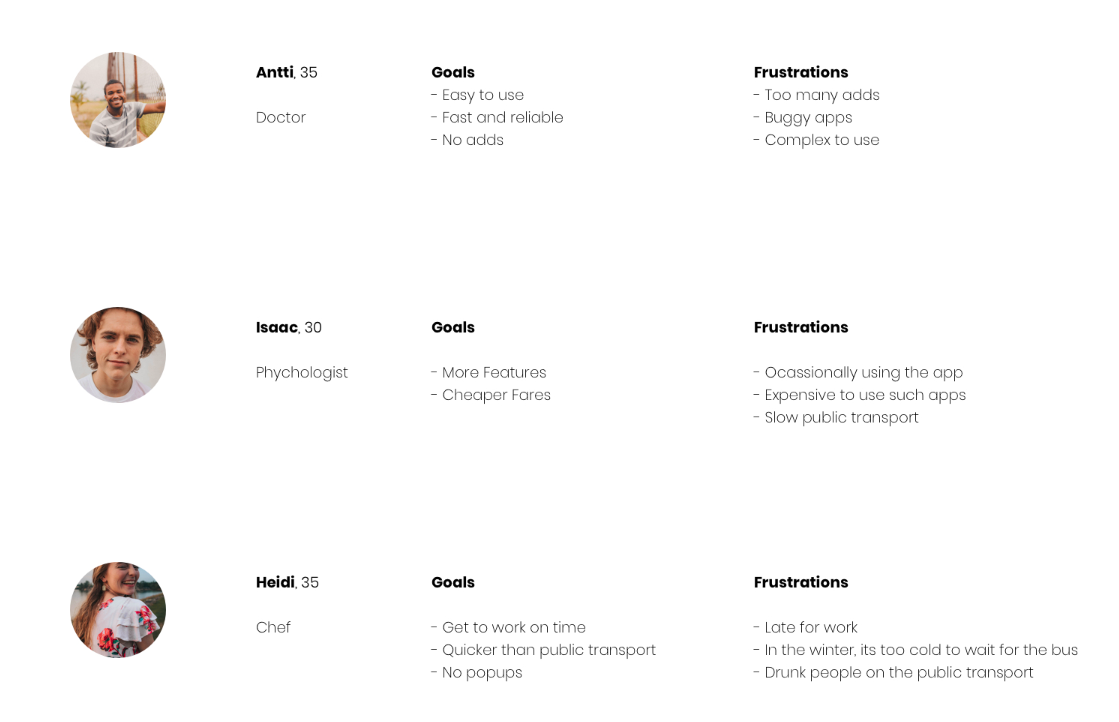
User Flows
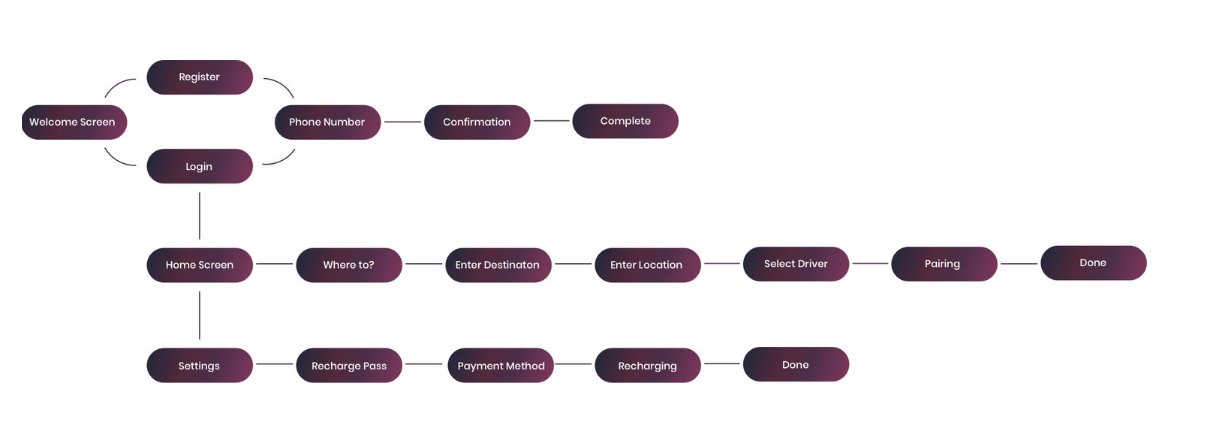
Low Fidelity Wireframing
Low fidelity wireframes were made using Balsamiq.
- The flow on the extreme left is how a user would register to the app using their phone number
- The second flow on the right shows how a user would find a ride for themselves
- The third flow on the bottom is how a user would recharge their monthly pass
The column on the left is showing iOS wireframes while on the right we have the Android counterpart.
All the flows were designed to bearing the K.I.S.S (keep it simple stupid) technique.
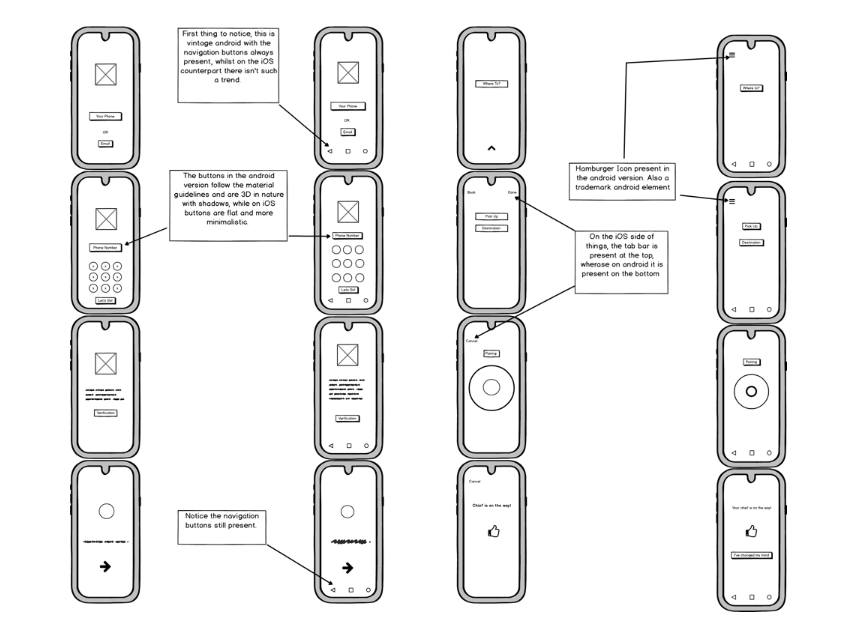
These low fidelity wireframes were made using Balsamiq.
In the 3rd flow specifically, there were a lot of last minute changes made in the later stages of the project. However, the initial sketches helped out a lot in laying down the foundation for later stages of the project.
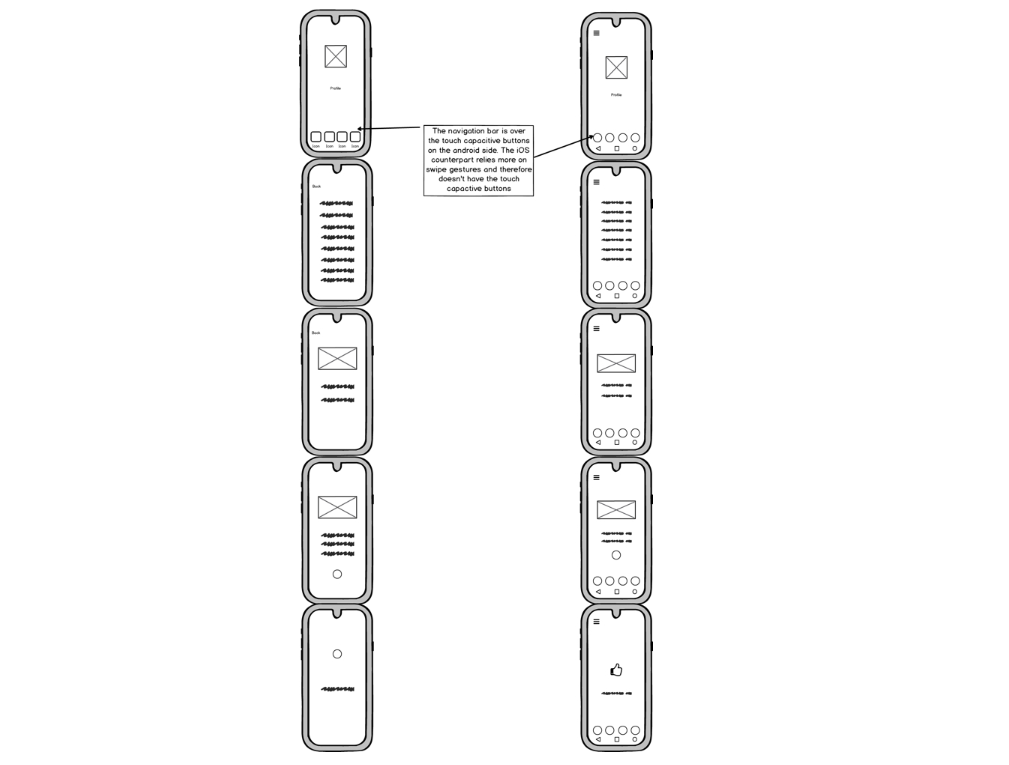
Mid Fidelity Wireframing
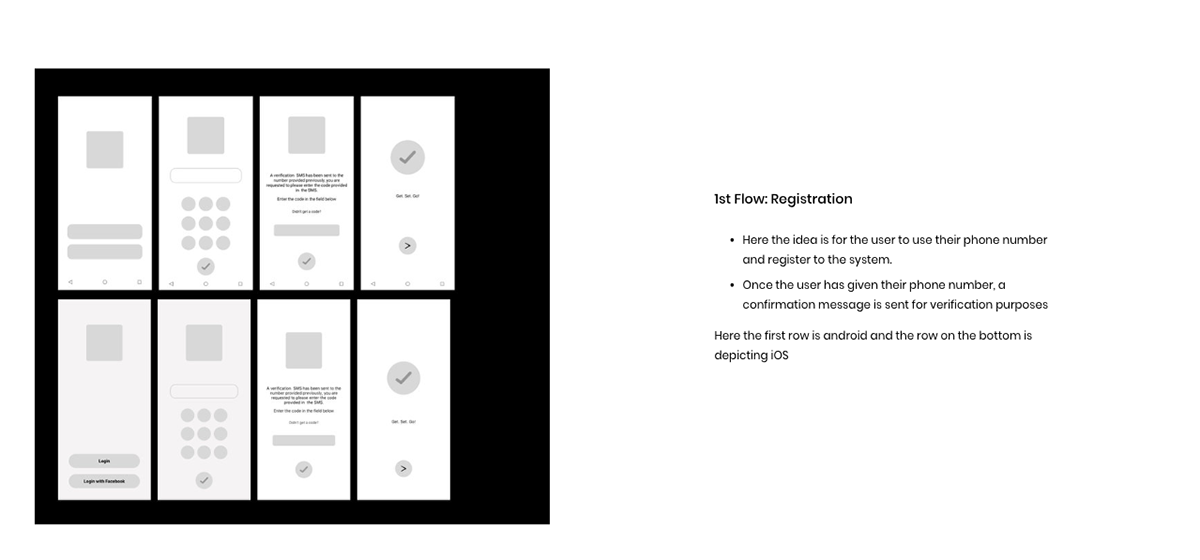
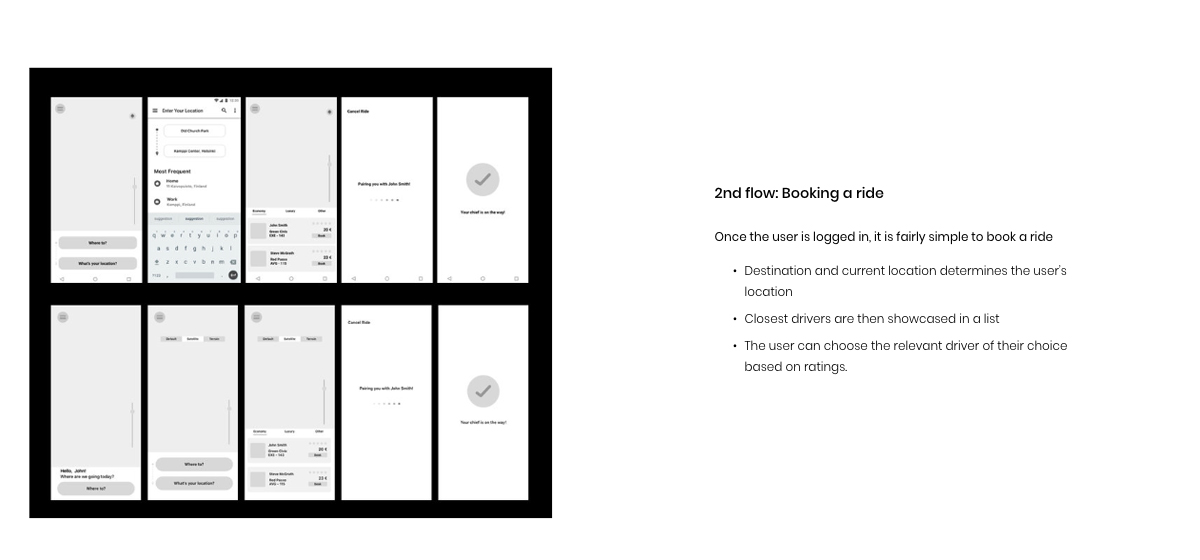
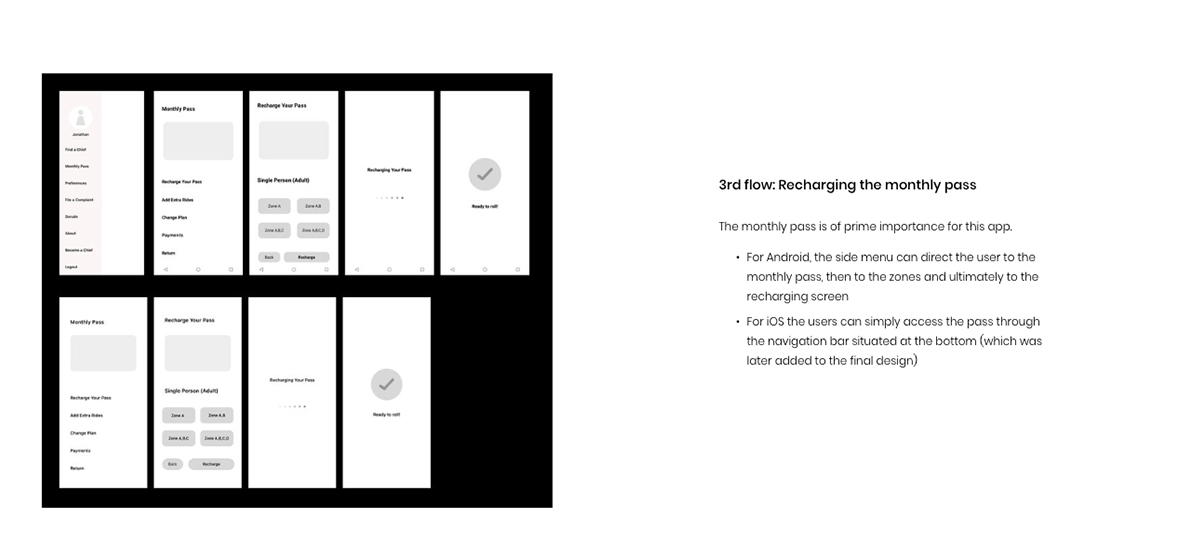
Final Product
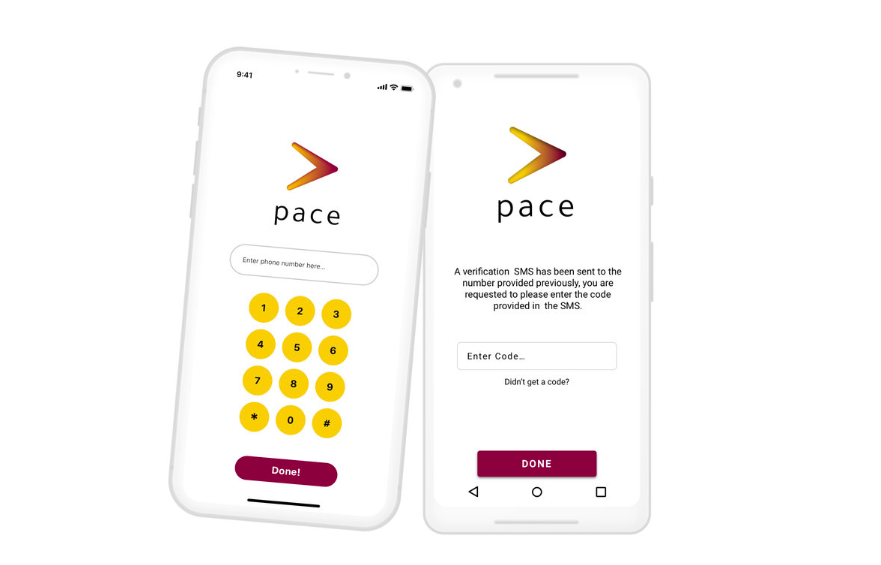
Final screens showing how the users can register using their phone numbers (iOS on the left and Android on the right). The user enters their number and a confirmation message is sent to them and through that they can register to the system.
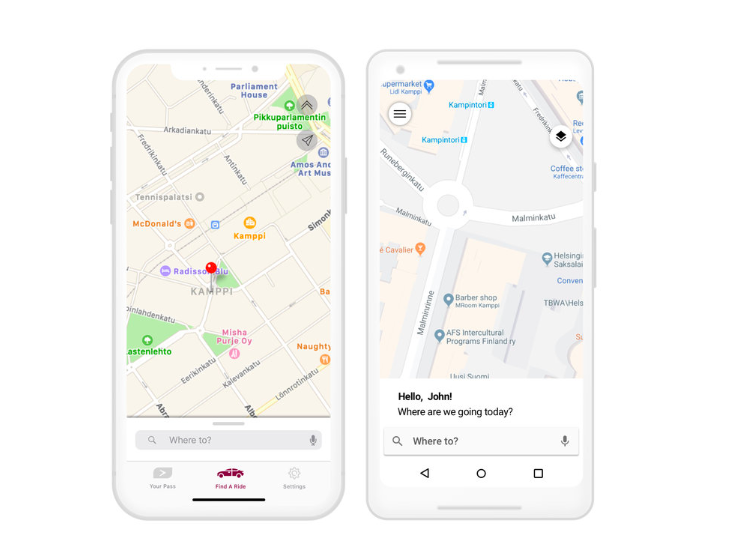
Home screens: Notice the navigation bar in the iOS mockup (L), Whereas, Android counterpart relies on the side screen menu (hamburger menu button, top left). The focus is largely on clarity and for the UI to blend in the background and let the user navigate properly. The screens shown are for iOS.
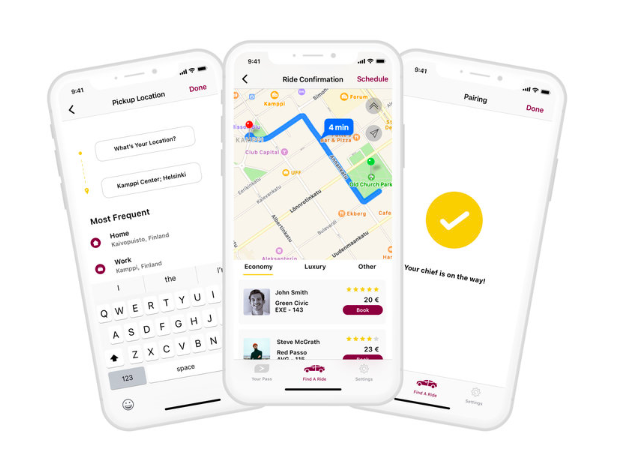
Booking a ride is simple and easy. The user enters their destination and the app either automatically detects their location or is entered manually. After that, the user is paired with a driver and it is possible for the user to either book a ride straight away or schedule it for later.
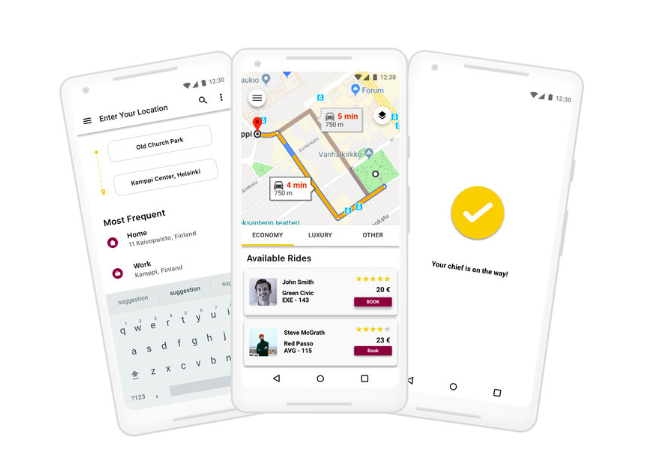
Android has the same flow. Except for the fact that the native elements are different. The cards shown have shadows. There is a search bar up at the top, the hamburger menu is still present and can be accessed.
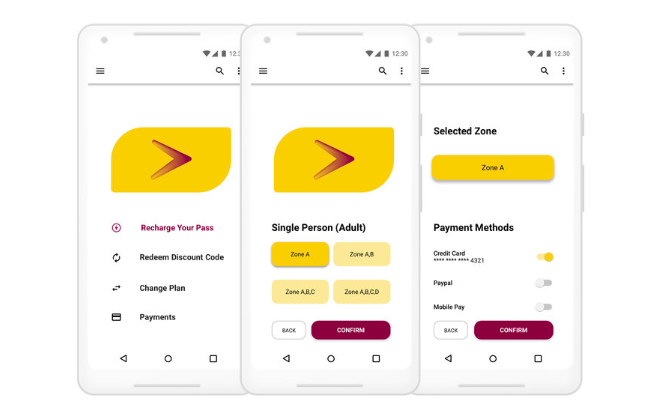
Here, iOS is depicting how to recharge the monthly pass. This menu can be accessed from the settings button in the navigation bar at the bottom. The pass can be purchased based on different zones, which signify areas within or around the city. Once the commuting area is suggested. The user can pay through a card, PayPal or other applications.

Android again, showing the same flow, i.e. how to recharge the monthly pass. Here the screen on the extreme left can be accessed from the hamburger menu. The buttons and the cards displayed are based on android guidelines.
Other Portfolios
Daniel Cho's Portfolio Project
Daniel Cho
Devanshi Vasa's VUI Portfolio Project
Devanshi Vasa
Devanshi Vasa's Portfolio Project